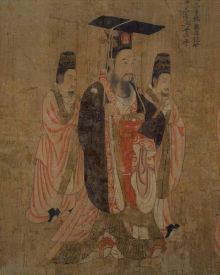Difference between revisions of "Emperor Wen of Sui" - New World Encyclopedia
({{Contracted}}) |
|||
| Line 46: | Line 46: | ||
{{end box}} | {{end box}} | ||
| − | [[Category: | + | [[Category:History and biography]] |
| − | [[Category: | + | [[Category:Biography]] |
| − | |||
| − | |||
| − | |||
| − | |||
| − | |||
| − | |||
| − | |||
| − | |||
| − | |||
{{credit|99042966}} | {{credit|99042966}} | ||
Revision as of 01:04, 11 March 2007
Emperor Wen of Sui (541-604), personal name Yang Jian, was the founder and first emperor of China's Sui Dynasty. He was a hard-working administrator and a micromanager. As a Buddhist, he encouraged the spread of Buddhism through the state; however, his government officially supported Confucianism.
As an official in the Northern Zhou Dynasty, Yang Jian seized power in 581. When the womanizing Emperor to the Northern Zhou dynasty died an untimely death, the next Emperor became Wendi's grandson through his daughter, who was the Empress and the official wife of the late Emperor (he had 5 Empresses). At this time Yang Jian was already in charge of the day-to-day runnings of the imperial court in the capital, because the late Emperor was not interested in governing himself. Yang Jian was appointed to be one of the two regents for the six-year old boy and after surpressing a revolt by his co-regent in command of the armies of the east. He seized the throne for himself, establishing the new Sui dynasty.
After seizing the throne, Wendi declared himself the rightful possessor of the Mandate of Heaven. He invaded the Chen Dynasty in the south to reunite northern and southern China. Before invading, he distributed propaganda flyers in the south, declaring that the Chen ruler had lost the Mandate of Heaven because of his decadent rule, which eased the conquest of the south.
His first accomplishment was to consolidate governmental administration and centralize the political system. He established a more efficient two-body government to replace the existing three-tier system, and created three departments and six ministries for state supervision. Wendi took steps to breach the social gap between rich and poor, and to reduce corruption and encourage union of Chinese states. Political officials became qualified based on merit rather than blood, and imperial examinations were instituted. Elite-class privileges, which had long been part of the social system in the northern dynasties, fell. Capable officials from the south were welcomed to join his government.
In this reign, the land-equilization system was created, distributing land equally based on household size, with more land for larger families. However, existing landholders were allowed to keep their property, and land could not be sold off, only farmed. Taxes on farmers and merchants were relaxed, as well, and overall the period became very agriculturally productive.
Wendi saw the beginning of the construction of the Grand Canal. This huge project had the purpose of uniting northern and southern China with improved transport. It was completed in the reign of his son, Yangdi. Another project of his time was the improvement and expansion of the Great Wall.
Wendi is usually thought to have been strangled at the hands of the prince, who had been stripped of his title after being caught raping one of Wendi's concubines. However, some people believe he died of illness.
As an Emperor Wendi is famous for his "Kai Huang Lü" which became the basis for all legal codes of subsequent dynasties of China until the overthrow of the Qing in 1911.
Generally speaking, Wendi's reign is a great period of prosperity not seen since the Han Dynasty. Economically, the dynasty prospered out of its ruins. It is said that there was enough food stored for 50 years. The military was also powerful. At the beginning of his reign, there was the Great Turkish Horde, a few other minor barbarian hordes to the north, Tibetan tribes to the west, Koguyou in the northeast, and a Vietnam kingdom enroaching on Sui lands from the south. By the time Wendi finished his reign, the Great Turkish Horde has split into the Eastern and Western hordes, and the only possible threat that remained was the Eastern Turks. The Western Turks were too far in the west from Central China to be a threat. A lot of the small hordes were subdued. Though Eastern Turks were still a threat, Wendi gave Sui the clear advantage. Eventually, in the beginning of Yangdi's reign, the Eastern Turks will temporary become a vassal of the Sui (Eastern Turks officially break that vassal relationship in 615 when the Turks attacked and surrounded Yangdi at Yianmen). Unfortunetly, his successor-Yangdi practically ruined all that work.
Wendi is also famous for having the least amount of concubines for an adult Chinese Emperor who have ruled so long. Wendi had only 2 concubines, and those are only after his empress and longtime wife died. Tang Taizong, by comparison, is said to have over 3000 concubines in his palaces.
Template:Succession box three to oneCredits
New World Encyclopedia writers and editors rewrote and completed the Wikipedia article in accordance with New World Encyclopedia standards. This article abides by terms of the Creative Commons CC-by-sa 3.0 License (CC-by-sa), which may be used and disseminated with proper attribution. Credit is due under the terms of this license that can reference both the New World Encyclopedia contributors and the selfless volunteer contributors of the Wikimedia Foundation. To cite this article click here for a list of acceptable citing formats.The history of earlier contributions by wikipedians is accessible to researchers here:
The history of this article since it was imported to New World Encyclopedia:
Note: Some restrictions may apply to use of individual images which are separately licensed.
